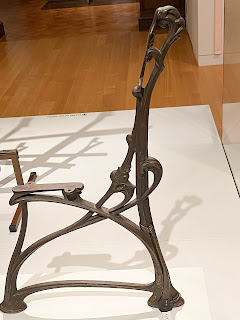I have written a number of Missives about the Frick Collection and Henry Clay Frick’s daughter as well. There is even one about what would happen when the Frick had to leave it’s home while a building renovation was happening at the Mansion.
So it moved to the former Whitney Museum which was built by Marcel Breuer in his brutalist style. It is the antithesis of the Frick’s home. In 2020 I wrote I would be jealous of anyone who saw this new installation which was scheduled to last for 2 years but like all construction the Frick Collection will remain there for another year.
Finally, after 4 years, we were in New York again and this was our first destination. We were so pleasantly surprised. They did not try to recreate the Frick Mansion style but rather show the works of art to their best advantage by creating smaller rooms in some cases and using the Breuer architecture to its best advantage in others. The installation Is on the 2nd, 3rd and 4th floors with paintings, sculpture and decorative arts organized by period, geographic region and media.
Wisely, they did not try to squeeze too much into the space, instead, have a wonderful representation of what my father would have called “their greatest hits”. If I tried to list them it would just be volume one of the catalog.
Instillation is so important to get the most out of a work of art. On the first exhibition floor you are greeted by this bronze angel from 1475 by Jean Barbet. She is by herself, greeting you as the doors to the elevator open, such a wonderful moment and introduction to the collection.
Tastes change and as a boy, I would have taken home the famous Giovanni Bellini (circa 1430 – 1516) “St. Francis in The Desert”. Here it has been isolated, giving it it’s own space so the viewer is not distracted by other masterpieces along side. Every time I see the painting I see something new. This time, though I preferred seeing it in the mansion, in its new bright light, I could see more detail. I discovered that St. Francis has a cane near his bible. Using a cane these days, I could appreciate that!
 |
| Photo Credit: Joe Coscia |
 |
| Detail from above |
Today, however, I would like to leave with a much smaller masterpiece. It is the Duccio di Buoninsegna (circa 1255 – circa 1319) “The Temptation of Christ on the Mountain”. I find it such an enticing fantasy, not trying to paint an actual scene but rather an evocation of the moment.
My Wife’s favorite work, which always has her tears, is a great Rembrandt self-portrait. In it he shows himself off as just as important as any of his clients. He has no problem promoting himself which I guess an artist in any field needs to do in order to be recognized and a financial success. Photography is not allowed in the Frick but it has been placed with two other Rembrandts, a nice but not great portrait and another favorite of mine titled, “The Polish Rider”. This photo will only give you a vague idea of the space.

A few have suggested that the Frick should stay where it is now. The Frick, however, is renting the space from the Metropolitan Museum that had leased it from its owner, The Whitney Museum for which it was built. Also, the will of Henry Clay Frick was very specific and so much would be lost for the city of New York. The Frick mansion with the collection that its owner bought for it is a rare commodity and gives a totally different ambience for an old master and decorative arts collection than the twenty-first century concept of showing works of art against stark white walls where in many cases, with their flat lighting might as well be posters.
Congratulations and thanks to Director, Ian Wardropper, chief curator Xavier Salomon and curator Aimee Ng for making this impossible transition and transformation into such a wonderful temporary experience.

































